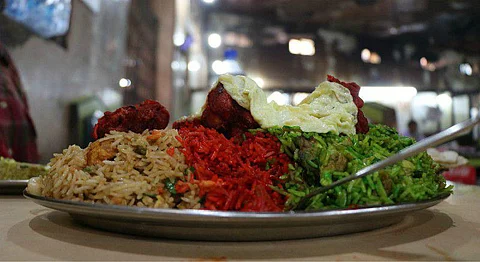
- HOMEGROWN WORLD
- #HGCREATORS
- #HGEXPLORE
- #HGVOICES
- #HGSHOP
- CAREERS
- ABOUT US
- CONTACT US

Someone once told me about how most Indians and Pakistanis living abroad enjoy a certain unlikely kinship. A shared history, a common language, similar cultures and a mutual love for food – in a foreign country, they have more things to bond over than fight about.
However, this celebration of similarities never transcends back to their homelands where the sheer mention of one another incites the worst kind of passions among citizens. e Geographic identities have been reduced to slurs, things to fight over, be arrested or even kill for, it represents the worst face of xenophobia and the lowest regard for humanity.
Fortunately, there are still places found in dreary corners of both countries, where the hatred towards the neighbour ceases to exist. Even people celebrating our shared history and cultural legacy in the most unique ways. Needless to say, food has been one such uniting factor and no one understands this better than Mohammad Jabir, the co-owner of Mumbai’s Radio Restaurant that offers a special India-Pakistan Biryani.
The restaurant, situated behind hundreds of hawker stalls in Musafir Khana in Mumbai, occupies a massive old godown – and could easily be mistaken for one, unless one steps in and smells the enticing aromas. Towards the left of the entry door is one of the kitchens where mounds of rice, colourful chutneys and minced meats is placed on the table in a suitably messy arrangement. Impossible to resist, I walk in and immediately place an order for the iconic ‘India-Pakistan Biryani’.
Within 20 minutes, it’s on my table. Three mounds of rice coloured in orange, green and white topped with a wholesome omelette and stuffed with chicken lollipops – it looks divine. I dig in making a mental note of the varied flavours I relish. Slightly tangy, with a hint of ginger and garlic, I realise that it tastes more like fried rice and less like Biryani.
Mohammad Jabir confirms the same. “It is actually Malaysian fried rice –
infused with chutneys and food colouring to give it shades of orange and green,” he says. Quite surprised to find out that the dish was actually foreign to both the countries, I ask him the reason behind naming it ‘India-Pakistan’. “I wanted to innovate, be a little different. People here loved the Malaysian fried rice but it was always considered a little too exotic by name. So I experimented a little with the chutneys and the food colouring and gave the name ‘India-Pakistan’ to it. When people see it, they are intrigued and immediately order it. I have been getting an amazing response. Moreover, everyone loves food. No matter what country they belong to. Food is the uniting factor and this dish symbolizes that. Hopefully, there will be peace among both the countries, someday,” he says smiling.
As I fork my omelette, struggling to finish the delicious India-Pakistan Biryani that can easily satiate four adults, Mohammad Jabir urges me to try the Murg Taliban – another dish on offer with a controversial name.
It has quite an arresting taste. (pun intended). Chunks of slow-cooked, chicken marinated in light cashew nut gravy, it smells heavenly. Slightly salty and perfectly spiced, I learn that the dubious naming of this dish too has been a marketing decision. “The chicken curry has been a family recipe for a long time. However, I wanted to give it an attention grabbing name. This was the time when Osama Bin Laden’s name was constantly in the news. Although I was a bit sceptical about using Taliban as a suffix, my friends said it won’t be a problem.” “Has it?” I ask him, interrupting. To my surprise, he says, “it never has.”
Honestly, I am a little disappointed that the etymology of both these dishes are merely marketing tactics and do not hold any roots in interesting events or cultural legacies of both India and Pakistan. But that feeling disappears as soon as I get back to relishing the delectable curry and observing the dingy restaurant which is now buzzing with diners.
A high ceiling, old creaky fans, pale-yellow walls and the constant hustle of servers and diners comprising of students, families, individuals coming to grab a bite after a day’s work – swiftly moving in and out. Voices echo and the entire space seems to have a notorious, unapologetic charm. Turns out it’s not one without reason. Apparently, this 88-year-old eatery used to be the adda of druglords in late 1960’s.
Mohammad Jabir smiles slyly and nods when I ask him to confirm. However, he refuses to give out any names and also clarifies that such nefarious activities have considerably gone down in the place now. The only guilty pleasures in Radio Restaurant (that satiates almost 8000 people on a good day) are those of overeating their colourful kebabs and feasting on their delicacies that stand out not just with their taste but also their intriguing names.
Needless to say, these pleasures are available to anyone belonging to any country, caste, creed or belief. Radio Restaurant encourages everyone to come together and weave themselves into a beautiful gastronomic tapestry of food for the soul.
All photographs taken by Samrat Nagar for Homegrown.
If you enjoyed reading this article, we suggest you read:
